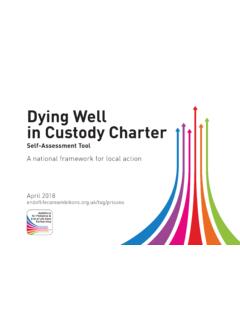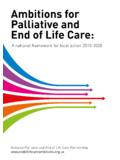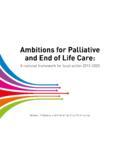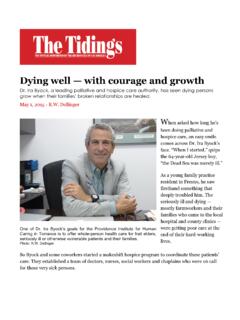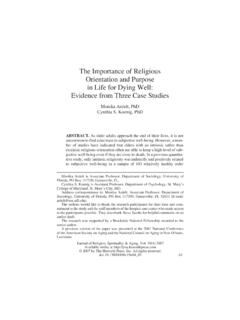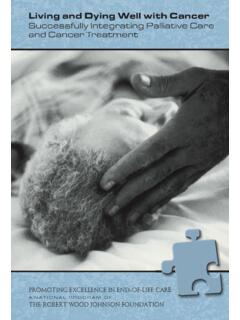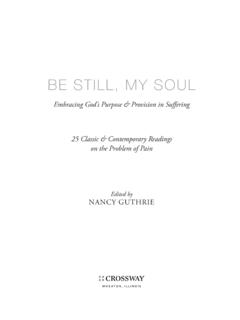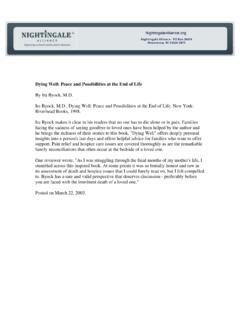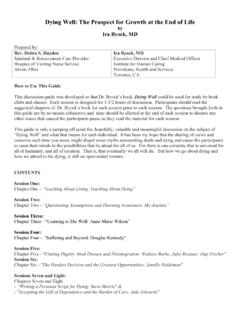Transcription of Dying Well in Custody Charter - endoflifecareambitions.org.uk
1 Dying well in Custody CharterApril 2018 for Palliative &End of Life CarePartnershipDying well in Custody Charter A national framework for local actionForewordDying well wherever you are and whatever your background or circumstances are fundamental aspects of human dignity. As part of a compassionate humane society, we need to do everything we can to make sure that people who are facing their last months, weeks and days of life receive the best possible palliative and end of life care. Those who care for them, including their families, others important to them and staff around them, equally deserve this consideration and co-chairs of the Ambitions Partnership, we are delighted that the Ambitions for Palliative and End of Life Care Framework has been applied to the context of the prison setting and interpreted as a Charter . To our knowledge, this is the first time anywhere in the world that the principle of equity has been applied in such a practical way.
2 This is truly a remarkable articulation of a set of standards, which are a set of guidelines setting out best practice, underpin each of the six ambitions and the development of a self-assessment tool to use alongside it has the potential to make a huge difference. Our shared vision is: I can make the last stage of my life as good as possible because everyone works together confidently, honestly and consistently to help me and the people who are important to me, including my carers . No matter where any prison is on the trajectory towards that vision, they will be able to use this Charter and self-assessment tool to help them continuously recognise that the custodial environment is different to other settings in which clinical care takes place, and that providing the best possible end of life care in prison is complex and challenging. It is precisely because of that, that we welcome this publication so would strongly encourage commissioners, leaders, staff and supporters of prison services to read this and, more importantly, use it to help them in their endeavours to improve the way in which each person can live and die well in Bee Wee Dr Jane CollinsNational Clinical Director of End of Life Care Chief Executive OfficerNHS England Marie Curie, UKCo-Chairs of the Ambitions for Palliative and End of Life Care PartnershipIntroductionIt remains a contentious position that anyone should experience a planned death in prison.
3 However, for some individuals compassionate release to alternative premises in which they can end their life is either not possible or unwanted and therefore there is a requirement that those individuals who do have a planned death in a custodial setting experience the highest standards of the community close friends and family are key and central to the individuals care yet in the prison environment are often forgotten or their role misunderstood when planning end of life care. Also, the support for close ones is key to the holistic care of the of the people in prison who are coming to the end of their life have been in prison for a number of years and are surrounded by staff and fellow prisoners with whom they are comfortable. The staff may well have been a consistent presence in their lives during their period of Custody and their peers are their friends and is for these reasons that I truly welcome this Dying well in Custody Charter .
4 The Charter mirrors the Ambitions for Palliative and End of Life Care and provides a framework for establishments to act, help and support all staff who are involved in the care of an individual preparing to die, many of whom will not have experienced supporting an individual in their planned death. This framework provides a set of standards sitting underneath 6 statements of Ambition which place the individual at the centre of the care being planned and Ambitions and Standards in the Dying well in Custody Charter ensure that care is co-ordinated across the establishment and supports all staff being able to achieve a level of competence and confidence in delivering professional care to these individuals with dignity and of life care is enormously important for the individual being cared for as it is for their friends, families and carers. It is the last thing that can be done for a living person and it is critical that it is done well .
5 This Dying well in Custody Charter enables those involved in caring for individuals to manage this event with compassion, inclusivity and ensures that there is dignity in the death irrespective of their place of Davies OBED irector of Health & Justice, Armed Forces and Sexual Assault Referral Centres (SARCs) NHS England April 2018 Dying well in Custody Charter Ambition 1: Each Person is seen as an Individual I Statement: I and the people important to me have opportunities to have honest, informed and timely conversations and to know that I might die soon. I am asked what matters most to me. Those who care for me know that and work with me to do what s possible. Standards A. Each prison will treat an individual with dignity and respect. B. Each prison has a palliative end of life register to identify individuals and enable care, support and holistic needs to be met. C. Information and support will be provided to the individual, their family and significant others and their concerns listened to.
6 D. A Family Liaison Officer should routinely be appointed, to support and co-ordinate care at end of life including family access, unless otherwise indicated. E. All care should be holistic, person centred, safe and decent with a process in place to support appropriate self-management. F. Open and informed honest conversations about individual expectations and preferences are facilitated and acted upon. G. Each individual is offered spiritual and religious support appropriate to their needs and preferences. H. The individual s care and management is delivered in partnership to allow access to a flexible, progressive prison regime according to need. Ambition 2: Each Person Gets Fair Access to Care I Statement: I live in a society where I get good end of life care regardless of who I am, where I live or the circumstances of my life. Standards A. Each individual s needs are identified, assessed and met regardless of a prison s location or category.
7 B. An individual s protected characteristics inform assessments and on-going care and steps are taken to meet needs accordingly. C. Each prison ensures access to 24/7 clinical advice for individuals on the palliative end of life care register. April 2018 Ambition 3: Maximising Comfort and Wellbeing I Statement: My care is regularly reviewed and every effort is made for me to have the support, care and treatment that might be needed to help me to be as comfortable and as free from distress as possible. Standards A. Each prison has a clear process for timely assessment and care planning of any identified and changing needs and preferences of the individual. B. All assessments of need are made by an appropriately qualified individual. C. Pain and symptoms are assessed and reviewed in a timely way using a multidisciplinary team approach to enable delivery of safe and effective pain and symptom management.
8 D. Medicines are available in the prison for prompt access and supply or administration. E. Anticipatory care including anticipatory prescribing, advance care planning and DNACPR decisions, is reviewed at key trigger points in the individual s care when required, and recorded. F. Joint assessments between healthcare and security will inform dynamic risk assessment for restraints for individuals on the palliative care register. G. Each prison has a process to initiate open door protocol when required. Ambition 4. Care is Coordinated I Statement: I get the right help at the right time from the right people. I have a team around me who know my needs and my plans and work together to help me achieve them. I can always reach someone who will listen and respond at any time of the day or night. Standards A. Each individual is offered the opportunity to be involved in the planning of their care which is regularly reviewed and shared appropriately with health and care professionals and those important to the individual, where requested.
9 B. Clear roles and responsibilities are identified and communicated to individuals and staff. C. Each prison s policy/guidance for palliative end of life care includes a clear outline of a multidisciplinary approach which includes the individual, representatives, prison roles and partners. D. There is a prison and clinical lead for palliative end of life care with clearly identified roles and responsibilities. This is outlined within local policy/guidance. E. Each individual has named clinical key worker/s. F. There is co-ordinated and clearly documented transfer/release plans for individuals using national SystmOne clinical template to ensure continuity of care. April 2018 Dying well in Custody Charter Ambition 1: Each Person is seen as an Individual I Statement: I and the people important to me have opportunities to have honest, informed and timely conversations and to know that I might die soon.
10 I am asked what matters most to me. Those who care for me know that and work with me to do what s possible. Standards A. Each prison will treat an individual with dignity and respect. B. Each prison has a palliative end of life register to identify individuals and enable care, support and holistic needs to be met. C. Information and support will be provided to the individual, their family and significant others and their concerns listened to. D. A Family Liaison Officer should routinely be appointed, to support and co-ordinate care at end of life including family access, unless otherwise indicated. E. All care should be holistic, person centred, safe and decent with a process in place to support appropriate self-management. F. Open and informed honest conversations about individual expectations and preferences are facilitated and acted upon. G. Each individual is offered spiritual and religious support appropriate to their needs and preferences.
